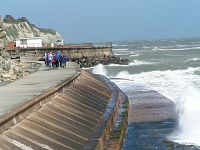
Photo from wikipedia
Abstract Urban nearshore ecosystems are built environments that differ structurally and functionally from the natural ecosystems they replace. Eco-engineering offers the ability to enhance these ecosystems by reducing the impacts… Click to show full abstract
Abstract Urban nearshore ecosystems are built environments that differ structurally and functionally from the natural ecosystems they replace. Eco-engineering offers the ability to enhance these ecosystems by reducing the impacts of shoreline modification. Recent studies have linked shoreline armoring and pier shade—common features of modified shorelines—to lower foraging rates, altered distribution patterns, and increased predation risk for juvenile salmon. The 2017 replacement of the Elliott Bay seawall in Seattle, WA, USA incorporated novel eco-engineering design elements, including glass light penetrating surfaces (LPS) in overwater structures, an elevated seafloor, and textured substrates in the seawall face to enhance nearshore habitat for juvenile Pacific salmon (Oncorhynchus spp.) migrating from natal streams to the ocean. To examine the effectiveness of seawall eco-engineering, we used snorkel surveys to assess changes in juvenile salmon spatial distribution and foraging patterns during peak outmigration (March–August), and measured ambient light penetration before and after seawall replacement. Overall, we found that juvenile salmon were distributed more evenly across a spatial mosaic of habitats following eco-engineering. LPS enhanced ambient light penetration in nearshore under-pier habitats, and juvenile salmon use of these habitats increased concurrently. Salmon densities under piers tended to be greatest at low tides, indicating that light availability may mediate selective habitat use. Feeding rates at sites immediately adjacent to the seawall increased both between and under piers following habitat enhancement. Our findings suggest that the elevated light levels facilitated by LPS, in concert with physical enhancements that provided more complex shallow water habitat, temper the negative effects of pier shade and shoreline armoring on juvenile salmon.
Journal Title: Ecological Engineering
Year Published: 2020
Link to full text (if available)
Share on Social Media: Sign Up to like & get
recommendations!